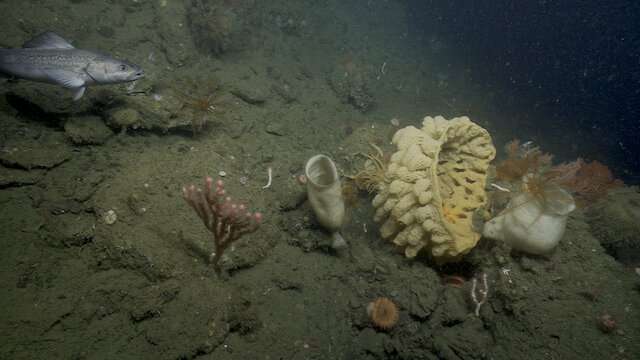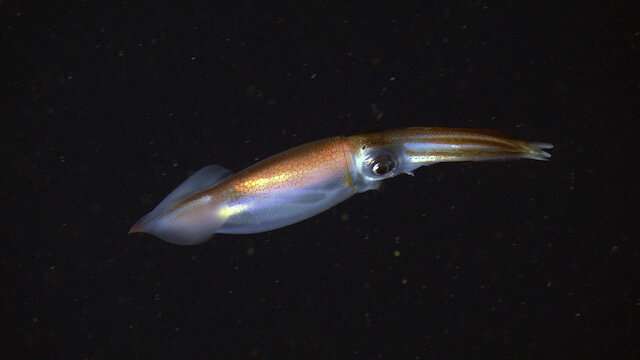Video is invaluable for MBARI research. The new MxD SeaCam underwater 4K camera MBARI developed with DeepSea Power & Light captures life in the deep sea in remarkable detail. This frame capture shows corals and sponges captured in 4K resolution at 60 frames-per-second. The corner-to-corner sharpness and low-distortion at the full-wide field of view is a hallmark feature of this camera. Credit: MBARI
A delicate drifter that grows longer than a blue whale, colorful gardens of ancient corals teeming with life, towering rocky chimneys spewing hot, mineral-rich water—the deep sea is home to astonishing animals and habitats.
High-definition, or HD, cameras on MBARI's remotely operated vehicles (ROVs) have recorded thousands of hours of video helping the institute's research team piece together the mysteries of Earth's largest, but least explored, living space.
Now, a collaboration between MBARI and DeepSea Power & Light has provided the tools to capture video in 4K ultra high-definition (UHD) resolution thousands of meters below the ocean's surface.
"Seeing the rapid adoption of 4K imaging and recognizing the scientific value that increased resolution brings to our research team, MBARI began evaluating opportunities to upgrade the HD camera systems on our ROVs to 4K in 2018," explained MBARI Electrical Engineer Mark Chaffey. "The new MxD SeaCam that we developed with DeepSea Power & Light captures life in the deep sea in astonishing detail."
Video is a precious—and unique—resource at MBARI.
In 34 years of deep-sea research, MBARI's ROVs have logged more than 5,800 dives. Research groups across the institute mine an associated archive of more than 27,600 hours of video to learn about the deep sea. Video is also important for education and outreach. Images and video recorded by ROVs Ventana, Tiburon (now retired), and Doc Ricketts are shared across MBARI's social media platforms and have been showcased in publications, productions, and exhibitions around the world.
Credit: Monterey Bay Aquarium Research Institute
"At MBARI, we annotate all of the video captured by our ROVs and permanently archive these discoveries into our one-of-a-kind Video Annotation and Reference Systems, or VARS. As we accumulate these highly valuable details, the bigger picture starts to come into clearer view and enriches our understanding about the different communities of deep-sea animals, the environments that they inhabit, and how things might be changing over time," explained Video Laboratory Manager Nancy Jacobsen Stout. "And, of course, this stunning imagery is simply mesmerizing and we enjoy sharing these inspirations with the public."
The last great advance in MBARI's video imaging capabilities was more than 20 years ago, when the institute transitioned to recording in an HD television format—1080i resolution, or 1920 by 1080 pixels. The higher quality enabled researchers to better document deep-sea animals and environments. With video imaging worldwide now transitioning to 4K resolutions, MBARI saw an exciting opportunity to develop a camera system that takes full advantage of the higher resolution, color rendition, dynamic range, and frame rates that this format offers. The team selected the broadcast-quality 4K UHD format with a pixel resolution of 3840 by 2160—a resolution exactly four times that of HD.
MBARI's mission is to advance marine science and technology to understand the changing ocean and disseminate this knowledge to the community at large. Partnering with a well-established commercial vendor helps MBARI transfer technology innovations to the global market. In October 2019, MBARI enlisted DeepSea Power & Light to develop the new underwater 4K camera. DeepSea Power & Light has extensive experience with glass camera domes at pressure and understood the challenges for developing a camera for MBARI's deep-diving ROVs.
"The creation of a new deep-ocean video camera system of the highest quality has significant technical challenges—and risk!" said Chaffey.
Designing a deep-water 4K camera required careful consideration about operating under extreme conditions—the deep sea is an unforgiving environment that is cold and under crushing pressure. Since MBARI's ROVs conduct hundreds of dives each year, reliability was also important.
Achieving the performance goals for the camera required a large, precision optical dome port that was larger than any commercial housing available for these depths at the time. The DeepSea Power & Light team had the expertise and tools for simulation, manufacturing, and validation needed to successfully produce a novel deep-water housing.
Credit: Monterey Bay Aquarium Research Institute
DeepSea Power & Light engaged Fathom Imaging to contribute the optical design, which was critical to realizing the full capabilities of the 4K format. To achieve high-resolution and low-distortion image targets across the camera's telephoto and focal range, Fathom Imaging was tasked with the design of a bespoke optical adapter.
"Each partner's area of specialization addressed the three major technical challenges: packaging the camera, designing the necessary optical lenses, and designing the deep-sea pressure housing and glass dome systems," explained Chaffey.
Over the last two years, the camera's ambitious design took shape. The result of this collaboration is the MxD SeaCam—a first-of-its-kind 4K underwater imaging system.
The MxD SeaCam camera was first deployed on MBARI's ROV Ventana for a series of test dives in the fall of 2021. The camera is now in active use for science operations on MBARI's other ROV, the Doc Ricketts. The first few expeditions utilizing the MxD SeaCam have already proven rewarding, providing high-quality video to fuel MBARI's research.
"4K gives us much higher resolution for studying the structure of the animals we investigate, particularly the transparent species," said MBARI Senior Scientist Bruce Robison, who studies life in the midwater. Many of the creatures that live in this vast expanse of water deep beneath the surface and far above the seafloor are notoriously difficult to film. "4K lets us see the fine details of how these animals are put together and how all the individual parts work, individually and together."
During an expedition in November, Robison and his team had the fortunate opportunity to record the rarely seen giant phantom jelly (Stygiomedusa gigantea) in 4K. This stunning species is more than one meter (about three feet) across and trails oral arms that are 10 meters (33 feet) long. It is too large to collect, so researchers depend on video observations to study its natural history, behavior, and ecology.
A 4K frame capture from the MxD SeaCam of the black-eyed squid (Gonatus onyx). The detail and highlights possible with the MxD camera are stunning, even for gelatinous organisms that are notoriously difficult to image. Credit: MBARI
Kyra Schlining—a senior research technician in MBARI's Video Lab—joined Robison for his expedition. She recalled the encounter with Stygiomedusa, "When we scanned it close up it looked like both the outside of the bell and the arms were covered in nematocysts. These details become more apparent with 4K. The level we can zoom in to is truly amazing."
Beyond offering a detailed look at deep-sea animals and habitats, MBARI scientists are excited about how the higher resolution and powerful zoom capabilities can improve their research. "Because of the high resolution, we can stand off, farther away from the animal we are investigating, than was the case with our former HD cameras," said Robison. "This is important because our proximity to the animals can bias their behavior, so the farther away we can be and still see clearly, the better."
The MxD SeaCam camera provides an exciting new level of visibility into the deep sea. The footage captured by this camera promises to advance not only research, but also education. Images are the most powerful way to communicate the beauty and importance of the deep sea and share the scientific knowledge and discoveries made there with the public.
4K video from MBARI will be featured in an upcoming exhibition from the institute's education and conservation partner, the Monterey Bay Aquarium. Into the Deep: Exploring Our Undiscovered Ocean will transport visitors into the largest living space on Earth, telling stories of the creatures that live there and the people and discoveries that are illuminating the last unexplored reaches of our planet. Opening April 9, 2022, the new exhibition will bring visitors face-to-face with deep-sea animals and showcase MBARI video, including new and never-before-seen 4K footage.
Provided by Monterey Bay Aquarium Research Institute

























